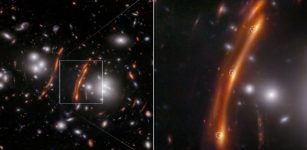Unusual Laser Emission Reveals Double Star System Hidden At The Heart Of Ant Nebula
MessageToEagle.com – An unusual laser emission has been discovered by an international team of astronomers using European Space Agency’s (ESA) Herschel space observatory.
The laser emission suggests the presence of a double star system hidden at the heart of the “spectacular” Ant Nebula and it is the extremely rare phenomenon.
When low- to middleweight stars like our Sun approach the end of their lives they eventually become dense, white dwarf stars. In the process, they cast off their outer layers of gas and dust into space, creating a kaleidoscope of intricate patterns known as a planetary nebula.
Our Sun is expected to one day form such a planetary nebula.
A nebula is an interstellar cloud of dust, hydrogen, helium and other ionized gases. The Ant Nebula earns its nickname from the twin lobes that resemble the head and body of an ant.
The new data shows that the Ant Nebula also beams intense laser emission from its core. In space, laser emission is detected at very different wavelengths and only under certain conditions. Only a few of these infrared space lasers are known.
“We detected a very rare type of emission called hydrogen recombination laser emission, which is only produced in a narrow range of physical conditions,” Dr Isabel Aleman, lead author of a paper describing the new results, said in a press release.
“Such emission has only been identified in a handful of objects before and it is a happy coincidence that we detected the kind of emission that Menzel suggested, in one of the planetary nebulae that he discovered.”
This kind of laser emission needs very dense gas close to the star. Comparison of the observations with models found that the density of the gas emitting the lasers is around ten thousand times denser than the gas seen in typical planetary nebulae and in the lobes of the Ant Nebula itself.
Normally, the region close to the dead star – close in this case being about the distance of Saturn from the Sun – is quite empty, because its material is ejected outwards. Any lingering gas would soon fall back onto it.
“The only way to keep such dense gas close to the star is if it is orbiting around it in a disc,” co-author Prof Albert Zijlstra, from the Jodrell Bank Centre for Astrophysics in the School of Physics & Astronomy, added.
“In this nebula, we have actually observed a dense disc in the very centre that is seen approximately edge-on. This orientation helps to amplify the laser signal.
“The disc suggests there is a binary companion, because it is hard to get the ejected gas to go into orbit unless a companion star deflects it in the right direction. The laser gives us a unique way to probe the disc around the dying star, deep inside the planetary nebula.”
MessageToEagle.com










![Scientific visualization of a numerical relativity simulation that describes the collision of two black holes consistent with the binary black hole merger GW170814. The simulation was done on the Theta supercomputer using the open source, numerical relativity, community software Einstein Toolkit (https://einsteintoolkit.org/). Credit: Argonne Leadership Computing Facility, Visualization and Data Analytics Group [Janet Knowles, Joseph Insley, Victor Mateevitsi, Silvio Rizzi].)](https://www.messagetoeagle.com/wp-content/uploads/2021/07/artifintelgrvitwaves01-307x150.jpg)
